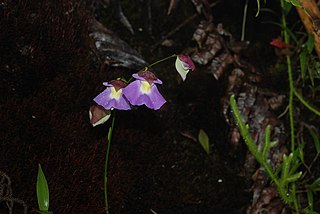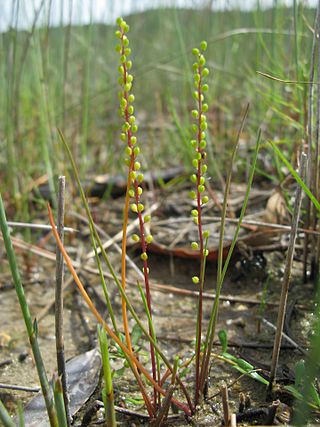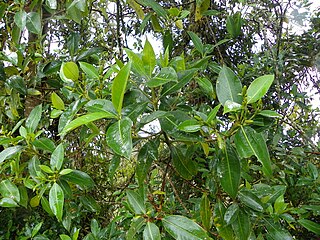
Toxicodendron striatum is a South American poisonous tree in the family Anacardiaceae. It is commonly called manzanillo and grows in the tropical rain forests on low elevation slopes.

Iriartea is a genus in the palm family Arecaceae. It is native to Central and South America. The best-known species – and probably the only one – is Iriartea deltoidea, which is found from Nicaragua, south into Bolivia and a great portion of Western Amazonian basin. It is the most common tree in many forests in which it occurs.
Huertea is a genus of plant in family Tapisciaceae. It is native to central and south America. Species include:

Citronella mucronata, the huillipatagua, naranjillo, or Chilean citronella tree, is an evergreen tree in the family Cardiopteridaceae. It is endemic to Chile and grows in the Chilean matorral region of central Chile from 30º to 40° south latitude.

Utricularia unifolia is a species of perennial, medium-sized carnivorous plant that belongs to the family Lentibulariaceae. U. unifolia is native to Central America and western South America. It was originally published and described by Hipólito Ruiz López and José Antonio Pavón Jiménez in 1797 and later considered a synonym of Utricularia alpina until Peter Taylor's 1989 monograph on the genus where he restored the species as distinct from U. alpina. It grows as a terrestrial or epiphytic plant on moss-covered trees, rocks, or banks in cloud forests at altitudes between 2,000 m (6,562 ft) and 3,000 m (9,843 ft). U. unifolia usually produces only one leaf, which is where the species epithet "unifolia" is derived from.

Bowlesia incana is a species of flowering plant, known by the common name hoary bowlesia, in thefamily Apiaceae. It is native to South America and the southeastern and southwestern United States as far north as Washington. It can also be found in Pakistan and New Zealand as an introduced species. It grows in many types of habitat. This is a small annual herb growing thin, spreading stems less than 60 centimeters long. The leaves are borne on long petioles and have multilobed rounded or kidney-shaped blades less than 3 centimeters wide. The green herbage of the plant is coated in fine white hairs. The inflorescences of yellow-green flowers appear in the leaf axils. The tiny inflated fruit is only 2 millimeters wide.

Porlieria is a genus of flowering plants in the caltrop family, Zygophyllaceae. Species within this genus are shrubs or small trees of dry subtropical regions. The generic name honours Spanish ambassador Don Antonio Porlier de Baxamar.

Chondrodendron tomentosum is one of six accepted species in the small genus Chondrodendron, belonging to the Moonseed family Menispermaceae. It is a large tropical liana native to Central and South America. It contains highly toxic alkaloids and is one of the sources of the arrow poison curare – specifically 'tube curare', the name of which is derived from the name of the medicinally valuable alkaloid tubocurarine.

Triglochin striata is a species of flowering plant in the family Juncaginaceae. It is native to New Zealand, South America, America, Africa, Australia and Southern Portugal.

Tillandsia capillaris is a species of flowering plant in the family Bromeliaceae. This species is native to southern and western South America.

Gaiadendron is a genus of parasitic shrubs or trees in the family Loranthaceae. It solely comprises the species Gaiadendron punctatum, which is found in North and South America.

Cavanillesia umbellata is a species of trees in the family Malvaceae. It is native to South America.

Escallonia resinosa is a species of evergreen shrub or tree in the family Escalloniaceae. It is native to the Andean forests of Peru, Bolivia and southern Ecuador from 2600 to 4200 meters above sea level. A component of high Andean forests, it is regarded as an important source of raw materials for the Andean peoples.

Escallonia paniculata is a species of tree in the family Escalloniaceae. It is native to Costa Rica, Panama and South America.

Persea caerulea is a species of evergreen tree in the laurel family, Lauraceae. It is native to North and South America.

Hedyosmum racemosum is a species of tree in the family Chloranthaceae. It is native to South America.
Godoya is a genus of trees in the family Ochnaceae. It is native to South America.

Fuchsia apetala is a species of small shrub or vine in the family Onagraceae. It is native to Bolivia and Peru.

Campomanesia lineatifolia is a species of plant in the family Myrtaceae. Common names include guabiraba and perfume guava.
















